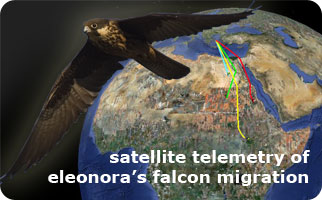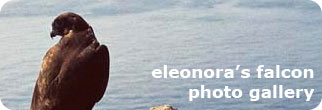Informational leaflet on the Eleonora's falcon and the programme LIFE - Nature
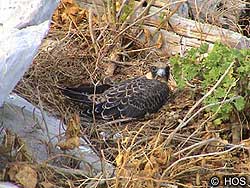 The Greek seas are dotted with innumerable small, uninhabited islets. These islets aid the journey of millions of birds flying over the Mediterranean, and constitute valuable nesting grounds for important and rare species in search of quiet and safety. It is in our hands to protect these areas as a significant natural inheritance worth saving for the future.
The Greek seas are dotted with innumerable small, uninhabited islets. These islets aid the journey of millions of birds flying over the Mediterranean, and constitute valuable nesting grounds for important and rare species in search of quiet and safety. It is in our hands to protect these areas as a significant natural inheritance worth saving for the future.
Ecology
A characteristic species to be found on the islets is the Eleonora's falcon, called in Greece Mavropetritis, but also known in many parts of the Aegean as Varvaki. It is a migratory falcon that nests in colonies on uninhabited islets or steep, inaccessible cliffs of inhabited islands. It arrives to nest in the Mediterranean in April and returns to Madagascar and other islands of the Indian Ocean for its winter stay by the end of October.
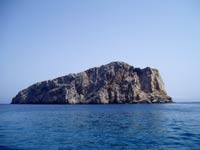 Until the end of July, the diet of the Eleonora's falcon consists mainly of large insects, such as grasshoppers, beetles and night butterflies. In order to secure its prey, the falcon has to travel large distances, very often reaching mountains, wetlands and cultivated areas of big islands and the mainland of Greece.
Until the end of July, the diet of the Eleonora's falcon consists mainly of large insects, such as grasshoppers, beetles and night butterflies. In order to secure its prey, the falcon has to travel large distances, very often reaching mountains, wetlands and cultivated areas of big islands and the mainland of Greece.
In August and September, when raising its chicks, the Eleonora's falcon dramatically changes its dietary habits and feeds almost exclusively on small migratory birds crossing the Mediterranean on their way to Africa. The Eleonora's falcon breeds in late summer, so as to secure food for its chicks, since their raising coincides with the autumn migration period. It is the only bird in the Northern hemisphere that breeds such a season.
Greece offers a home to about 4.500 pairs of Eleonora's falcon, which constitutes 72% of its global population. This fact means that Greece has the largest share of responsibility for the conservation of the species globally. At the same time, the Eleonora's falcon is the most important bird species for Greece.
Threats
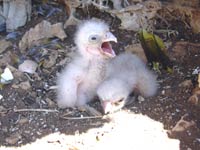 For the past years, a decrease in the world population of the Eleonora's falcon has been observed in some areas of the Aegean. It seems that the main cause is the use of poisonous substances in the cultivation of land; however, the increase of disturbance in the nesting grounds also contributes to the problem. The rapid increase of tourism, with recreational boats (speedboats, sailboats etc) has rendered the once isolated islets accessible. The presence of visitors at the colonies, however, disturbs the birds and causes them to leave their nests temporarily, exposing them to the sun, the heat as well as to predators. If the disturbance becomes intense, they may even desert their nests permanently.
For the past years, a decrease in the world population of the Eleonora's falcon has been observed in some areas of the Aegean. It seems that the main cause is the use of poisonous substances in the cultivation of land; however, the increase of disturbance in the nesting grounds also contributes to the problem. The rapid increase of tourism, with recreational boats (speedboats, sailboats etc) has rendered the once isolated islets accessible. The presence of visitors at the colonies, however, disturbs the birds and causes them to leave their nests temporarily, exposing them to the sun, the heat as well as to predators. If the disturbance becomes intense, they may even desert their nests permanently.
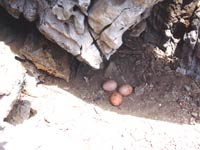 Many islets have been settled by rats that arrived there as stowaways on boats that dropped anchor at the shores or close to the islets. The eggs of the Eleonora's falcon frequently constitute easy prey for the rats, especially when the parent birds have drawn away, frightened by visitors to the islets. Other uncontrollable activities, such as illegal hunting, the presence of domestic animals and buildings, the lighting of fires and the destruction of the flora can further contribute to the degradation of the islets' biotopes.
Many islets have been settled by rats that arrived there as stowaways on boats that dropped anchor at the shores or close to the islets. The eggs of the Eleonora's falcon frequently constitute easy prey for the rats, especially when the parent birds have drawn away, frightened by visitors to the islets. Other uncontrollable activities, such as illegal hunting, the presence of domestic animals and buildings, the lighting of fires and the destruction of the flora can further contribute to the degradation of the islets' biotopes.
Natura Network 2000
The most important areas where the Eleonora's falcon breeds have been integrated as Zones of Special Protection in the Natura Network 2000, based on the European Directives on the conservation of birds and their habitats. This network includes the most important habitats in Europe and has as its aim the safeguarding of the long-term survival of the most rare and threatened species and habits, through measures and policies that promote alternative forms of local development, such as ecotourism, agro tourism, biological farming and livestock breeding.
The programme LIFE
 The Hellenic Ornithological Society (HOS), after having been active these last years in the Aegean region, has acquired significant experience it now utilises in the materialisation of the programme LIFE - NATURE ‘Activities for the protection of the Eleonora's falcon in Greece'. It is a four-year programme (2003-2007) and is carried out in co-operation with the Natural History Museum of Crete, the Greek Ministry of Rural Development and Food and the Royal Society for the Protection of Birds (RSPB). It is co-financed by the Leventis Foundation. It covers the totality of Greece, but also undertakes significant activities in other Mediterranean countries where the species breeds.
The Hellenic Ornithological Society (HOS), after having been active these last years in the Aegean region, has acquired significant experience it now utilises in the materialisation of the programme LIFE - NATURE ‘Activities for the protection of the Eleonora's falcon in Greece'. It is a four-year programme (2003-2007) and is carried out in co-operation with the Natural History Museum of Crete, the Greek Ministry of Rural Development and Food and the Royal Society for the Protection of Birds (RSPB). It is co-financed by the Leventis Foundation. It covers the totality of Greece, but also undertakes significant activities in other Mediterranean countries where the species breeds.
Within the programme's framework, the first world-wide census of the Eleonona's falcon population is being realised, research and the observation of its breeding in the major Greek colonies are being conducted, site conservation programmes are being designed in co-operation with organisations in charge and pilot-activities concerning the management of the species' habitats are being implemented. These activities are being complemented by a widespread information campaign, the hosting of events, the production of leaflets, environmental education material and documentaries about the Eleonora's falcon and the islets' wildlife.
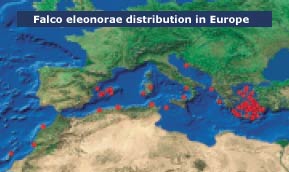
How you can assist in the protection of the Eleonora's falcon
- If you discover that the area where you have disembarked is breeding grounds for Eleonora's falcons, do not get near them and leave the area as soon as possible. Please inform your fellow travellers about the problem.
- If you find an injured or a dead bird, please contact the HOS ( Hellenic Ornithological Society) (210 8228704), the Greek Recovery Centre for Wild Fauna (22970-31337, 210-9520117), or the Natural History Museum of Crete (2810-393279, 324366).
- If you see Eleonora's falcons in the area you inhabit or where you are spending your vacation, please make a note of their number, their activities, where you saw them, time and date, and then send this information to HOS. You can find more information on recording procedures in the HOS-website.
- Become members of or support HOS by contributing directly or indirectly in the materialisation of protection activities.
More information: www.ornithologiki.gr
The Hellenic Ornithological Society (HOS), official partner of Birdlife International (the global federation of organisations for the protection of birds), was founded in 1982 and is today one of the country's most significant environmental organisations; it is the only one that focuses exclusively on the study and protection of wild birds and their habitats. Systematically recording the condition of the birds in Greece, HOS has studied hundreds of significant sites, many of which are protected today, in accordance with Greek and European legislation







